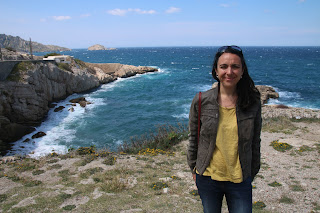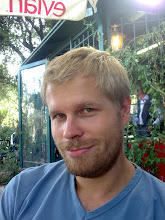Mathilde's dad and Francoise were spending a bit of time in the South of France. Since they decided to spend a week or so in the Vacluse, not far from here, before making their way over here to the Cote d'Azur, we decided to join them near Mont Ventoux for a couple of days during the weekend.
We headed off early Saturday morning, destination l'Isle-sur-la-Sorgue, a redez-vous point we had selected kind of randomly, as it's supposed to be rather nice, and it meant we could spend a few hours exploring the area before heading off to Bedoin, where we were staying the night.
It is indeed a very pleasant, quite typical Provençal town. No stunning historic monuments to be found here, just a laid-back, colourful town, with plenty of antique shops, cafés, and restaurants (so a pretty touristy town, then, but not oppressively so). The name of the town suggests its an island, the reason for this is that the town is located on the Sorgue river - it splits into several canals where the town is located, which gives the impression the town centre is on an island.
After a picnic lunch in a little park just outside the town centre (which could've counted as a quiet picnic spot if it wasn't for the cheerleader concert taking place during our lunch). Our appetites sated, we spent a good hour or so walking around the town, before stopping at the main square for an ice cream at one of the bars, enjoying the sunshine. We also checked out the many water wheels for which the town is famous.
Our next destination was another small Provençal town called Pernes-les-Fontaines. I really loved this little town. As the name suggests, the town is littered with fountains (that's Provence for you!) - 40 of them in total! There's a "fountain" walking tour that we decided to take on, which took us past the main sights in town.
Again, there are no famous historic monuments here as such, it's just a very nice little picturesque town to walk around - especially when the weather is nice like it was on this day. We hiked all the way up to the old medieval castle, from where we had some very nice views across the medieval village and the surrounding country-side. There was also a nice medieval church outside the town centre we checked out.
We then headed out to Bedoin, where we were spending the night. We were staying at the local VTF (a kind of holiday village), which meant we could cool off in the swimming pool, and then enjoy a buffet dinner, yummie! The legendary Mont Ventoux (with its height of 1912 meters, it's known as the Giant of Provence - some of you will be familliar with the place thanks to its inclusion in the Tour de France bicycle race) can also be seen from the VTF. Well, can usually be seen - unfortunately the top of the mountain was hidden behind some clouds this time around.
The next day, after a rather filling buffet breakfast, we decided to explore Bedoin. It's a rather pretty little village, one with a bloody past. During the French revolution, it was a pro-Royalist stronghold, as a result of which it was completely destroyed in 1794. It's been rebuilt since, and is now a quite typical Provence town. The main charm of the town is the site - located at the foot of Mont Venteux. Indeed, it's the main reason for the towns fame - it's the starting point of one of the routes that head up to the summit. So plenty of cyclists and hikers around...
After lunch at the VTF, it was time for me and Mathilde to head back to the Cote d'Azur. We did decided to stop by at Carpentras - one of the most famous towns in Provence, before heading off. Carpentras is mostly known for its farmers market, which takes place each Friday. We were, unfortunately, visiting on a Sunday, so the place was rather dead.
The two most famous buildings at Carpentras are of a religious nature. The most famous building is probably the impressive cathedral. Carpentras was actually home of the papacy under Clement V, after which the papacy was moved to nearby Avignon (home of the famous Palais des Papes). The cathedral is rather impressive seen from the outside - unfortunately it was closed to visitors when we checked it out. There is also a reminder of the Roman era by the cathedral - a discrete arch, quite well preserved.
The second famous religious in Carpentras is the synagogue - actually the oldest one in France. From the outside, it's very discrete indeed. The synagogue is a reflection of Carpentras' large jewish populations that dates back to the medieval ages (they found refuge here since the papacy provided refuge for them). Apparently the interiour is very impressive and interesting, again, unfortunately the place was closed to visitors...
Apart from that, Carpentras is quite an ordinary Provençal town, a bit run down like many towns of this size, in this part of France. The place merits an afternoon stroll, but there are prettier places in Provence. We ended our visit with a coffee and some sweets at a café across the street from the impressive Hôtel-Dieu (a Hôtel-Dieu is the medieval equivalent of a hospital. And then, time to head back to the Riviera, after a relaxing couple of days spent in beautiful Provence. Great to see Joel and Francoise again!
We headed off early Saturday morning, destination l'Isle-sur-la-Sorgue, a redez-vous point we had selected kind of randomly, as it's supposed to be rather nice, and it meant we could spend a few hours exploring the area before heading off to Bedoin, where we were staying the night.
It is indeed a very pleasant, quite typical Provençal town. No stunning historic monuments to be found here, just a laid-back, colourful town, with plenty of antique shops, cafés, and restaurants (so a pretty touristy town, then, but not oppressively so). The name of the town suggests its an island, the reason for this is that the town is located on the Sorgue river - it splits into several canals where the town is located, which gives the impression the town centre is on an island.
After a picnic lunch in a little park just outside the town centre (which could've counted as a quiet picnic spot if it wasn't for the cheerleader concert taking place during our lunch). Our appetites sated, we spent a good hour or so walking around the town, before stopping at the main square for an ice cream at one of the bars, enjoying the sunshine. We also checked out the many water wheels for which the town is famous.
Our next destination was another small Provençal town called Pernes-les-Fontaines. I really loved this little town. As the name suggests, the town is littered with fountains (that's Provence for you!) - 40 of them in total! There's a "fountain" walking tour that we decided to take on, which took us past the main sights in town.
Again, there are no famous historic monuments here as such, it's just a very nice little picturesque town to walk around - especially when the weather is nice like it was on this day. We hiked all the way up to the old medieval castle, from where we had some very nice views across the medieval village and the surrounding country-side. There was also a nice medieval church outside the town centre we checked out.
We then headed out to Bedoin, where we were spending the night. We were staying at the local VTF (a kind of holiday village), which meant we could cool off in the swimming pool, and then enjoy a buffet dinner, yummie! The legendary Mont Ventoux (with its height of 1912 meters, it's known as the Giant of Provence - some of you will be familliar with the place thanks to its inclusion in the Tour de France bicycle race) can also be seen from the VTF. Well, can usually be seen - unfortunately the top of the mountain was hidden behind some clouds this time around.
The next day, after a rather filling buffet breakfast, we decided to explore Bedoin. It's a rather pretty little village, one with a bloody past. During the French revolution, it was a pro-Royalist stronghold, as a result of which it was completely destroyed in 1794. It's been rebuilt since, and is now a quite typical Provence town. The main charm of the town is the site - located at the foot of Mont Venteux. Indeed, it's the main reason for the towns fame - it's the starting point of one of the routes that head up to the summit. So plenty of cyclists and hikers around...
After lunch at the VTF, it was time for me and Mathilde to head back to the Cote d'Azur. We did decided to stop by at Carpentras - one of the most famous towns in Provence, before heading off. Carpentras is mostly known for its farmers market, which takes place each Friday. We were, unfortunately, visiting on a Sunday, so the place was rather dead.
The two most famous buildings at Carpentras are of a religious nature. The most famous building is probably the impressive cathedral. Carpentras was actually home of the papacy under Clement V, after which the papacy was moved to nearby Avignon (home of the famous Palais des Papes). The cathedral is rather impressive seen from the outside - unfortunately it was closed to visitors when we checked it out. There is also a reminder of the Roman era by the cathedral - a discrete arch, quite well preserved.
The second famous religious in Carpentras is the synagogue - actually the oldest one in France. From the outside, it's very discrete indeed. The synagogue is a reflection of Carpentras' large jewish populations that dates back to the medieval ages (they found refuge here since the papacy provided refuge for them). Apparently the interiour is very impressive and interesting, again, unfortunately the place was closed to visitors...
Apart from that, Carpentras is quite an ordinary Provençal town, a bit run down like many towns of this size, in this part of France. The place merits an afternoon stroll, but there are prettier places in Provence. We ended our visit with a coffee and some sweets at a café across the street from the impressive Hôtel-Dieu (a Hôtel-Dieu is the medieval equivalent of a hospital. And then, time to head back to the Riviera, after a relaxing couple of days spent in beautiful Provence. Great to see Joel and Francoise again!











































